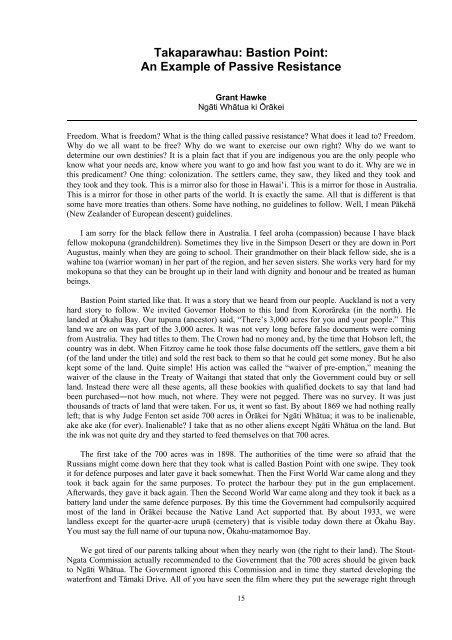traditional knowledge conference 2008 te tatau pounamu
traditional knowledge conference 2008 te tatau pounamu
traditional knowledge conference 2008 te tatau pounamu
Create successful ePaper yourself
Turn your PDF publications into a flip-book with our unique Google optimized e-Paper software.
Takaparawhau: Bastion Point:An Example of Passive ResistanceGrant HawkeNgāti Whātua ki ŌrākeiFreedom. What is freedom? What is the thing called passive resistance? What does it lead to? Freedom.Why do we all want to be free? Why do we want to exercise our own right? Why do we want tode<strong>te</strong>rmine our own destinies? It is a plain fact that if you are indigenous you are the only people whoknow what your needs are, know where you want to go and how fast you want to do it. Why are we inthis predicament? One thing: colonization. The settlers came, they saw, they liked and they took andthey took and they took. This is a mirror also for those in Hawai‘i. This is a mirror for those in Australia.This is a mirror for those in other parts of the world. It is exactly the same. All that is different is thatsome have more treaties than others. Some have nothing, no guidelines to follow. Well, I mean Pākehā(New Zealander of European descent) guidelines.I am sorry for the black fellow there in Australia. I feel aroha (compassion) because I have blackfellow mokopuna (grandchildren). Sometimes they live in the Simpson Desert or they are down in PortAugustus, mainly when they are going to school. Their grandmother on their black fellow side, she is awahine toa (warrior woman) in her part of the region, and her seven sis<strong>te</strong>rs. She works very hard for mymokopuna so that they can be brought up in their land with dignity and honour and be trea<strong>te</strong>d as humanbeings.Bastion Point star<strong>te</strong>d like that. It was a story that we heard from our people. Auckland is not a veryhard story to follow. We invi<strong>te</strong>d Governor Hobson to this land from Kororāreka (in the north). Helanded at Ōkahu Bay. Our tupuna (ancestor) said, “There’s 3,000 acres for you and your people.” Thisland we are on was part of the 3,000 acres. It was not very long before false documents were comingfrom Australia. They had titles to them. The Crown had no money and, by the time that Hobson left, thecountry was in debt. When Fitzroy came he took those false documents off the settlers, gave them a bit(of the land under the title) and sold the rest back to them so that he could get some money. But he alsokept some of the land. Qui<strong>te</strong> simple! His action was called the “waiver of pre-emption,” meaning thewaiver of the clause in the Treaty of Waitangi that sta<strong>te</strong>d that only the Government could buy or sellland. Ins<strong>te</strong>ad there were all these agents, all these bookies with qualified dockets to say that land hadbeen purchased―not how much, not where. They were not pegged. There was no survey. It was justthousands of tracts of land that were taken. For us, it went so fast. By about 1869 we had nothing reallyleft; that is why Judge Fenton set aside 700 acres in Ōrākei for Ngāti Whātua; it was to be inalienable,ake ake ake (for ever). Inalienable? I take that as no other aliens except Ngāti Whātua on the land. Butthe ink was not qui<strong>te</strong> dry and they star<strong>te</strong>d to feed themselves on that 700 acres.The first take of the 700 acres was in 1898. The authorities of the time were so afraid that theRussians might come down here that they took what is called Bastion Point with one swipe. They tookit for defence purposes and la<strong>te</strong>r gave it back somewhat. Then the First World War came along and theytook it back again for the same purposes. To pro<strong>te</strong>ct the harbour they put in the gun emplacement.Af<strong>te</strong>rwards, they gave it back again. Then the Second World War came along and they took it back as abat<strong>te</strong>ry land under the same defence purposes. By this time the Government had compulsorily acquiredmost of the land in Ōrākei because the Native Land Act suppor<strong>te</strong>d that. By about 1933, we werelandless except for the quar<strong>te</strong>r-acre urupā (ceme<strong>te</strong>ry) that is visible today down there at Ōkahu Bay.You must say the full name of our tupuna now, Ōkahu-matamomoe Bay.We got tired of our parents talking about when they nearly won (the right to their land). The Stout-Ngata Commission actually recommended to the Government that the 700 acres should be given backto Ngāti Whātua. The Government ignored this Commission and in time they star<strong>te</strong>d developing thewa<strong>te</strong>rfront and Tāmaki Drive. All of you have seen the film where they put the sewerage right through15
















